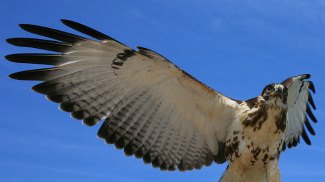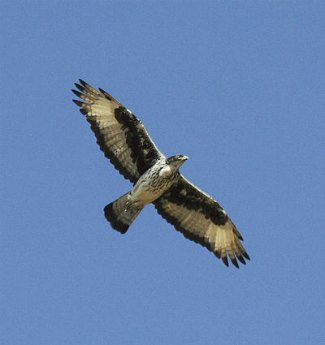African Hawk Eagle - Aquila spilogaster
By Steve Jurvetson, CC-BY-2.0, via Wikimedia Commons
Family: Accipitridae
Genus: Aquila
Species: A. spilogaster
African Hawk Eagles are medium-sized eagles with brown, white, and black markings. They live in dry woodland areas and are widely distributed across sub-Saharan Africa. They form a superspecies with Aquila fasciata (Bonelli's Eagle).
Physical Description:
African Hawk Eagles have black upperparts, flight feathers, and a black tail. The undertail is white with thin bars and has a thick black terminal band and trailing edge. The primary feathers have brown and white bases and the secondary feathers have pale gray bars. The neck is white and there are dark stripes along the breast and flanks. The beak is black with a light-colored cere. The head and crown are also black, and the feathered legs are white. Female African Hawk Eagles are more heavily streaked than males.
Juveniles have dark brown upperparts and white bars on their wing coverts and scapulars. The breast and coverts are streaked with brown, and the underwing and underparts are rufous. The wing and tail patterns are duller than adults', and their tails do not have a black band.
The call of African Hawk Eagles is a "kluu kluu kluu" or "kwee oo"; they do not call while flying.
By Chris Eason, CC-BY-2.0, via Wikimedia Commons
Size:
Length: 55-65 cm
Wingspan: 130-160 cm
Weight: Male: 1.15-1.40 kg. Female: 1.40-1.75 kg.
Habitat and Distribution:
They occur in savannah, open woodland, and areas where there are rocky cliffs and wooded streams, tending to avoid lowland forests close to the equator, dense forest, and arid regions in southwest Africa. They are usually found from 0-1,500 m above sea level, but can live up to 3,000 m.
African Hawk Eagles are found from western Africa in Senegal and Gambia east to Ethiopia and Somalia and then south to northeastern South Africa. Their total range spans from 15°N to 30°S, or 12,400,000 km². Adults are sedentary, though they will move to avoid drought.
Diet and Hunting:
They will take large birds such as guineafowl and francolins, along with reptiles and small mammals. Their prey can weigh as much 4 kg.
They hunt while flying or from a perch and catch their food either from the air or from the ground. They will also find a perch over a waterhole and wait for birds that come to drink. Occasionally, African Hawk Eagles will hunt in pairs: one eagle will flush out the prey while the other makes the kill.
Reproduction:
Displays consist of soaring and calling, and pairs are monogamous.
By whifflepeg, CC-BY-2.0, via Wikimedia Commons
The nest is bowl-shaped and around 1 meter wide. It is usually located in the fork of a high tree along a wooded river bank and made of sticks. Nests have also been found on electricity pylons and cliff faces, and African Hawk Eagles occasionally use those of other birds. 1-2 eggs are laid during October-March if north of the equator and April-January in southern regions. Incubation takes 43-44 days, and the eggs are incubated by both parents. Only the one chick is cared for if multiple eggs hatch, due to siblicide (also known as Cainism, where the older chick kills the younger). The young leave the nest after around 73 days and are fully independent around three months after that.
Conservation:
African Hawk Eagles are currently listed as Least Concern by BirdLife International. The population is thought to be declining due to woodland habitat destruction, but not at the rate required for Vulnerable status.
Taxonomy:
Aquila spilogaster used to be considered a subspecies of Aquila fasciata (Bonelli's Eagle), but the two are now classified as separate species based on the genetic distance between them.
Spilogaster comes from the Greek for "a spot on the belly".
Other Names:
Grootjagarend (Afrikaans), Orel savanový (Czech), Afrikansk Høgeørn (Danish), Afrikaanse havikarend (Dutch), Aafrika haugaskotkas (Estonian), Afrikanvuorikotka (Finnish), Aigle fascié (French), Afrikanisher Habichtsadler (German), Aquila minore Africana (Italian), Momojirokumataka (Japanese), Ekangakodi (Kwangali), Afrikahaukørn (Norwegian), Orzelek afrykanski (Polish), Águila-azor Africana (Spanish), Tai Kumbamti (Swahili), Afrikansk hökörn (Swedish).
Video of an African Hawk Eagle:
References:
http://avibase.bsc-eoc.org/species.jsp?avibaseid=9A418C4525EAB2B1
http://www.biodiversityexplorer.org/birds/accipitridae/aquila_spilogaster.htm
BirdLife International (2012) Species factsheet: Hieraaetus spilogaster. Downloaded from http://www.birdlife.org on 18/05/2012.
Global Raptor Information Network. 2012. Species account: African Hawk-eagle Aquila spilogaster. Downloaded from
http://www.globalraptors.org on 18 May. 2012
BirdLife International 2009. Hieraaetus spilogaster. In: IUCN 2011. IUCN Red List of Threatened Species. Version 2011.2.
www.iucnredlist.org. Downloaded on 18 May 2012.
http://www.kenyabirds.org.uk/h-eagle-af.htm
http://www.krugerpark.co.za/africa_hawk_eagle.html
Ferguson-Lees, James, and Christie, David A. Raptors of the World. Houghton Mifflin Company, 2001.
http://sabap2.adu.org.za/docs/sabap1/137.pdf
http://www.wilkinsonsworld.com/tag/african-hawk-eagle/


